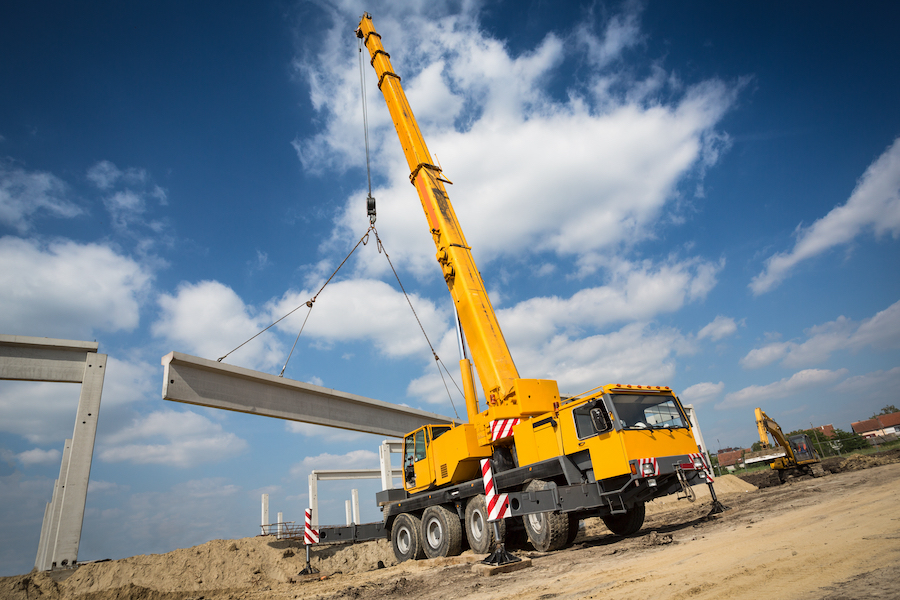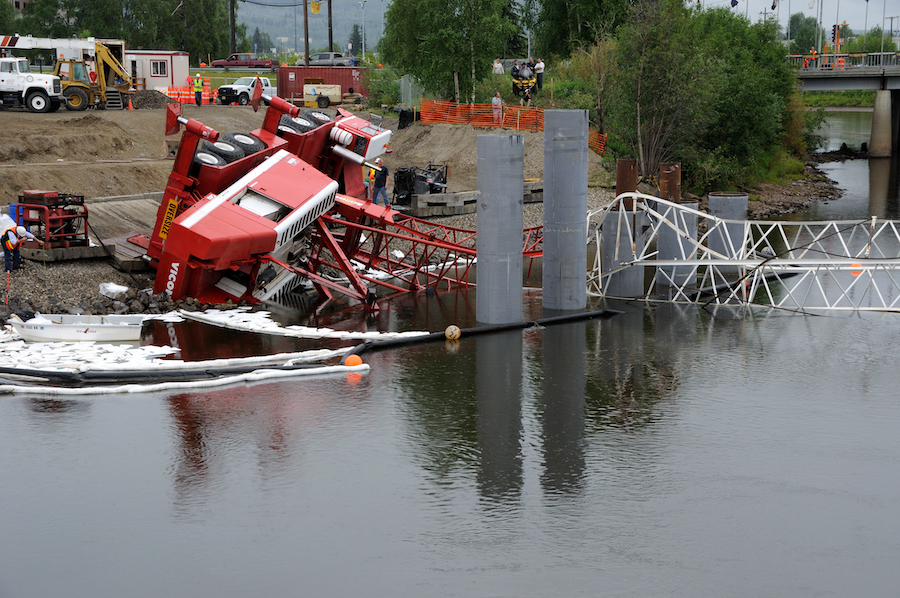
View the complete article here.
Whether it is construction crane hoisting, dockside container loading, or warehouse forklift operations—the accurate determination of load weight is crucial. The purpose of this guide is to educate contractors on the best practices for safely and accurately assessing the weight of a load. It also highlights the severe risks associated with neglecting these practices, which can lead to catastrophic equipment failure and endanger lives.
Understanding Load Weight
When it comes to the weight of a load in lifting operations, it is paramount to understand the type of equipment needed—as well as the consequences for ignoring best practices.
Definition of Load Weight in Lifting Operations
Load weight encompasses the total mass that lifting equipment must handle. This includes the weight of the load itself, the rigging gear, and any other attachments or accessories used during the lift. Thorough knowledge of this weight is the cornerstone of any lifting operation, ensuring that the process is carried out safely and efficiently.
The Importance of Load Weight in Equipment Selection
Selecting the appropriate lifting equipment hinges on an accurate assessment of load weight. Cranes, hoists, and other lifting devices are rated by maximum load capacity. To maintain operational safety, the actual load weight must be well within the limits of the equipment’s capacity. This selection process can be a delicate balance: too little capacity risks equipment failure and safety breaches, while too much capacity can lead to unnecessary expense and operational inefficiency.
Consequences of Miscalculating Load Weight
The repercussions of miscalculating load weight can be severe, ranging from project delays and financial loss to catastrophic equipment failure and fatal accidents. Excess weight can cause lifting equipment to behave unpredictably, potentially leading to loss of load control and the risks that follow. Furthermore, regulatory bodies like OSHA impose strict rules on weight calculations in lifting operations—and failure to comply can lead to penalties, legal issues, or operational shutdowns. Therefore, precise determination of load weight is not just a matter of best practice but a legal requirement and a critical aspect of workplace safety.

Pre-Lift Planning
Regarding pre-lift planning—it is important to have a full understanding of the site assessment, as well as all of the stakeholders involved.
Site Assessment, Equipment Selection, and Lift Planning
Before initiating any lift, a comprehensive pre-lift plan is essential for a safe and successful operation. The first step is a detailed site assessment—which involves evaluating the work area for potential hazards, assessing ground conditions, and ensuring that the space is adequate for the lift. Following the site assessment, selecting the appropriate lifting equipment is crucial. This choice should be based on the load weight, the reach required, and the specific conditions of the lift site. Finally, creating a detailed lift plan is always recommended. This plan should outline the lifting procedure, designate areas for the equipment, and specify the placement of the load. This plan acts as a blueprint for the entire operation, ensuring that everyone involved is informed about the process and that all safety protocols are in place.
Involving All Stakeholders
Stakeholders include operators, who will be handling the equipment—riggers, who are responsible for securing the load properly—and engineers, who ensure that the lift plan is feasible and that all calculations for load weight and equipment capacity are accurate. Each stakeholder plays a vital role, and their input is crucial in addressing all aspects of the lift—from safety to efficiency. Their collective expertise contributes to mitigating risks and improving the overall execution of the lifting process. For these reasons, involving all relevant parties in the planning stages is not just beneficial but necessary for the integrity of the operation.
Methods for Determining Load Weight
There are generally two approaches to determining load weight… direct and indirect.
Direct Methods
One of the most direct methods to determine the weight of a load is referring to the manufacturer’s specification sheet—which lists the weight of machinery, equipment, or material. This specification is provided by the manufacturer and is should be precise. However, it is essential to include the weight of any additional attachments or modifications—like spreader beams or grappling devices—not accounted for by the manufacturer’s specifications.
Another direct method is using a scale or load cell, which provides an actual weight reading of the load. This equipment is used to weigh the load in real-time and is highly accurate, ensuring that the lift operation can proceed with confidence in the load weight data.
Indirect Methods
When direct measurement is not possible or feasible, indirect methods can be utilized. These include calculations based on the load’s dimensions and the material density, which can be sourced from engineering references or material databases. This method requires careful consideration of the load’s volume and an accurate density value to determine the weight.
Another indirect method is the use of standard weight measures for common materials, like steel or concrete, which have known weight per unit volume. These estimations are less precise than direct measurements but can provide a reasonable approximation when other methods are unavailable.

Using Lifting Equipment’s Load Chart
A load chart is an essential tool that provides critical information about the lifting capacity of equipment (like cranes), and reading and interoperating these charts is essential for any contractor working in lifting environments.
Understanding Load Charts and Their Relation to Load Weight
This load chart indicates how the lifting capacity varies depending on factors such as the angle of the boom, the radius of the lift, and the height at which the load is being lifted. The chart is specific to each model of lifting equipment and takes into account the machine’s design and mechanical limits. Understanding how to match the load weight with the appropriate capacity listed on the load chart is essential to ensure the safety and success of a lift.
Reading and Interpreting Load Charts
To read a load chart properly, one must identify several key pieces of information: the maximum rated capacity, the load radius (the horizontal distance from the center of rotation to the center of the load), and the boom length and angle. The chart typically shows a grid with boom lengths and angles along one axis and the corresponding maximum safe lifting capacities along the other. It’s important to note that as the radius increases, the lifting capacity decreases. Operators must be trained to understand these charts thoroughly to ensure they do not exceed the equipment’s safe working limits.
Load Chart Example Scenario
Consider a scenario where a construction crew needs to lift a steel beam to the fourth floor of a building site. The load chart for the chosen crane shows that at the required radius of 30 feet and a boom angle of 60 degrees, the maximum safe lifting capacity is 10,000 pounds. The steel beam, along with its rigging equipment, weighs 8,000 pounds. By consulting the load chart, the crane operator can confirm that the lift is within the crane’s capacity at those specific conditions. This real-world application of the load chart ensures that the operation proceeds within the safety parameters, avoiding overloading the crane and potential accidents.
Safety Considerations and Best Practices
Needless to say, safety is paramount and should be considered during all phases of any lifting operation.
Ensuring Safety Through Accurate Load Weight Determination
The cornerstone of lifting safety is the accurate determination of the load weight. Every lifting operation must start with a precise calculation or measurement of the weight to be lifted. This figure must then be cross-referenced with the lifting equipment’s load chart to ensure the operation stays within safe limits. Accurate load weight determination prevents overloading, maintains the equipment’s structural integrity, and ensures that the lift can be carried out without exceeding the equipment’s operating capacity—thus safeguarding the crew and the load.
The Role of Safety Officers and Lift Directors
Safety officers and lift directors play a pivotal role in maintaining a safe lifting environment. Safety officers are responsible for enforcing safety standards and regulations, conducting risk assessments, and ensuring that all safety protocols are followed. Lift directors oversee the actual lifting operation, ensuring that the lift plan is executed correctly and that all personnel are aware of their roles and responsibilities. They also ensure that communication between the lift team members is clear and effective.
Best Practices for Documentation and Communication
Thorough documentation and clear communication are best practices that are vital to safe lifting operations. Documentation includes the lift plan, load weight calculations, equipment certifications, and inspection records. These documents should be readily available on-site and must be reviewed by the lift team prior to the operation. Communication, on the other hand, involves not just the initial briefing but also ongoing dialogue throughout the lift. This includes using hand signals, two-way radios, or other agreed-upon methods to communicate.

Troubleshooting Common Issues
Determining the weight of a load is a foundational step in lifting operations, yet it rarely occurs without some sort of challenge.
Addressing Common Challenges in Weight Determination
Weight determination can present several challenges, especially when dealing with irregularly shaped objects or when a load’s components have unknown specifications. Environmental factors such as wind, shifting loads, or even the condition of the lifting equipment can also impact the accuracy of weight determination.
To overcome these challenges, it’s crucial to employ a range of strategies—such as using the estimated weight of similar objects, consulting with experts who have experience with comparable lifts, or using advanced calculation methods that can account for the variables present.
Solutions and Alternatives When Exact Weight Cannot be Determined
In situations where the exact weight of a load cannot be determined, there are several alternatives to consider.
One approach is to use the maximum possible weight scenario for planning purposes. This conservative estimate ensures that the lifting equipment selected will be more than capable of handling the load under any circumstances.
Another solution is to employ load-sensing technologies, which can provide real-time data on the weight being lifted—allowing for adjustments during the lifting process. In addition, when available, using modular components of known weight to build up to the full load can provide a more incremental approach to determining the total weight. It is important to note that when exact weight cannot be determined, a significant safety margin must be included—and all lifting operations should proceed with extra caution.
Conclusion
In the high-stakes world of lifting operations, understanding and accurately determining load weight is not just best practice—it is a non-negotiable safety imperative. From the initial site assessment to the final execution of the lift, each step is underpinned by the precision of this critical figure.
View the complete article here.
What are the consequences of miscalculating load weight in lifting operations?
Miscalculating load weight can lead to severe repercussions, including project delays, financial loss, equipment failure, fatal accidents, and legal penalties for non-compliance with regulatory rules.
How can load weight be determined when direct measurement is not feasible?
Indirect methods, such as calculations based on dimensions and material density, or using standard weight measures for common materials, provide alternatives when direct measurement is not possible.













































